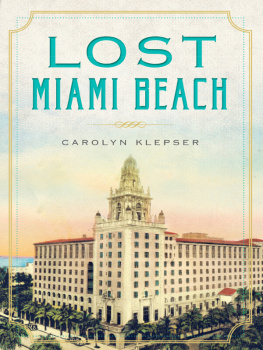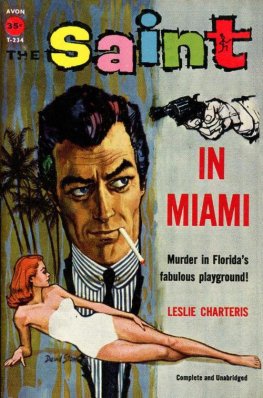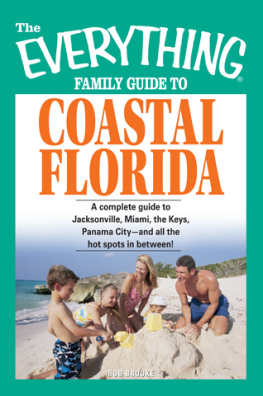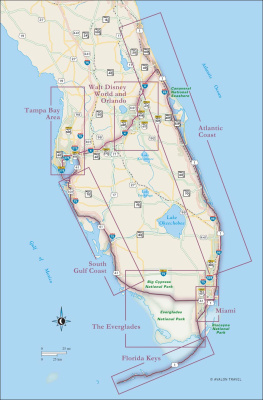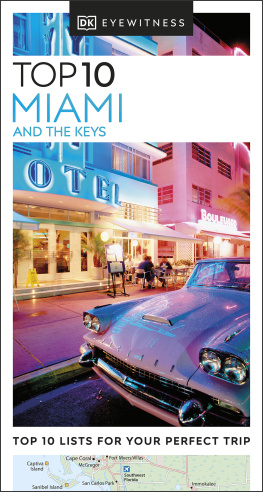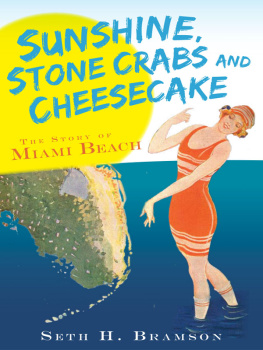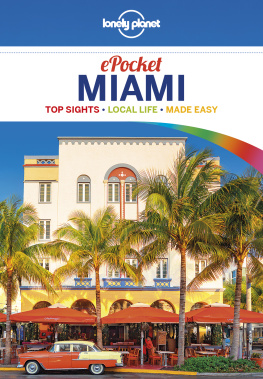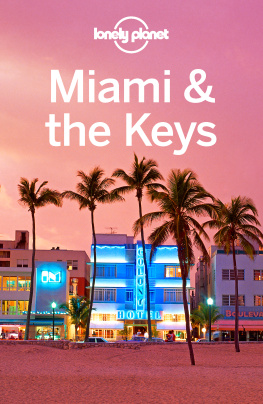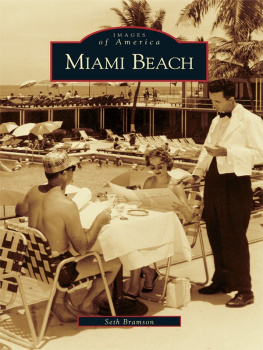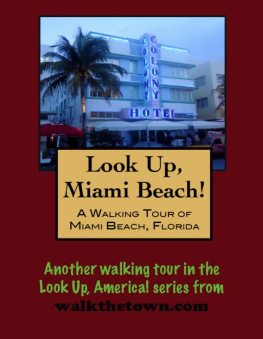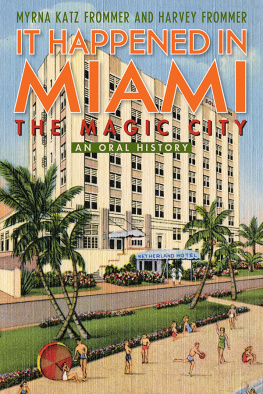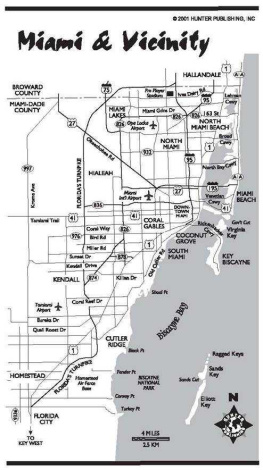
Roney Plaza Hotel demolition, 1968. Courtesy Arva Moore Parks, Miami News collection.

Published by The History Press
Charleston, SC 29403
www.historypress.net
Copyright 2014 by Carolyn Klepser
All rights reserved
Front cover: Postcard of the Roney Plaza Hotel. Courtesy of Larry Wiggins.
First published 2014
e-book edition 2014
ISBN 978.1.62584.959.5
Library of Congress Cataloging-in-Publication Data
Klepser, Carolyn.
Lost Miami Beach / Carolyn Klepser.
pages cm
Includes bibliographical references and index.
print edition ISBN 978-1-62619-428-1 (paperback)
1. Miami Beach (Fla.)--History. 2. Historic buildings--Florida--Miami Beach. 3. Historic sites--Florida--Miami Beach. 4. Miami Beach (Fla.)--Buildings, structures, etc. I. Title.
F319.M62K55 2014
975.9381--dc23
2014030016
Notice: The information in this book is true and complete to the best of our knowledge. It is offered without guarantee on the part of the author or The History Press. The author and The History Press disclaim all liability in connection with the use of this book.
All rights reserved. No part of this book may be reproduced or transmitted in any form whatsoever without prior written permission from the publisher except in the case of brief quotations embodied in critical articles and reviews.
CONTENTS
ACKNOWLEDGEMENTS
Many people helped in this project, and my thanks go to all of you. To name a few in particular: My friend Larry Wiggins not only contributed images from his legendary postcard collection but also tracked down many answers to research questions and, with unfailing patience, helped me with the cybernetics. Equal thanks go to my friend and mentor Arva Moore Parks, who also gave generously from her photograph collection and provided scanning and computer help and always inspiring encouragement.
At the City of Miami Beach, which has a trove of treasures in its archive, special thanks go to Liliam Hatfield in the City Clerks Office for her time and talent in mining these treasures and to Keith Valles for help with scanning. In the Planning Department, my thanks to Debbie Tackett, Michael Belush, James Murphy, Tui Munday and Laura Camayd for their help in accessing building records even when swamped with other duties.
At HistoryMiami, the regional museum formerly known as the Historical Association of Southern Florida, my gratitude goes to Rebecca Smith and Dawn Hugh in the research department for several images from their wonderful archive and to Ashley Trujillo for scanning them. At the Miami-Dade Public Library, for this and many other projects, John and Jennifer Shipley, Grisel Choter and others were unfailingly helpful with research and with images from another outstanding archive. Miami-Dade County should be ashamed of its relentless budget cuts to its library system.
Personal thanks go to Mr. Stanley Whitman for his kindness in sharing his firsthand memories, which brought the past to life for me, and to historian Dr. Paul George for his enthusiastic support and good advice: Just start writing!
INTRODUCTION
This book is perfect for armchair travelers, but it wont do much for tourism in Miami Beach. Most of the places it talks about are gone, so its no use coming here to see them.
Why should we care about what is lost? Well, if there is any value in studying history at all, in order to have a complete picture of it, we need to fill in the blanks. For instance, photos of some long-forgotten buildings seem to indicate that the Moderne, or Art Deco, architectural style arrived here earlier than most people thought. In addition, looking at the reasons past treasures were destroyedsome understandable, some notcan influence our present decisions in city planning and inspire our efforts to preserve what matters most to us. Then, too, visiting the past is just plain interesting. Two things that struck me about the old days in writing this book are: nobody was from here and they moved buildings a lot.
There is, of course, a heavy emphasis on architecture here; we are mostly looking at old buildings. This seems especially appropriate in Miami Beach, a town that is synonymous with Art Deco, where both residents and tourists appreciate the built environment. But I hope that this book brings to light some of what was here long before the Depression-era building boom. Nostalgia is not the purpose of this writing. The main focus is on buildings that are not only gone but also lost to memory. Yes, I, too, remember Pumperniks and Wolfies and the mural in front of the Fontainebleau, but I would rather tell you about the Community Theatre, the Aquarium, the Miami Beach Garden and how the city limits changed. That said, I have also included some buildings that have only recently been torn down in order to make the point that historic preservation is still an ongoing debate.
This book will probably mean more to people familiar with Miami Beach, but even if you are not, there are some good stories here, and you can also look at broader topics such as how cities evolve and what was going on in this corner of the nation in the 1920s.
Space does not allow for as many photographs here as you would probably like or mention of everything that has been lost over the years. I apologize for all that had to be left out. With few exceptions, I have limited the topics here to things within Miami Beach. Yes, I, too, remember Motel Row in Sunny Isles, but that will have to be another book.
Fortunately, Miami Beach is young enough that cameras have been around for its entire history. Photographs are the closest things we have to a time machine. Still, they are only a visual record. Many other aspects of life have changed as much as the built environment: this was a world of screened sleeping porches, wool bathing suits and trolley bells. Carsand their hornssounded different and were still something of a luxury. Plane travel (and they werent jets) was rare and miraculous. The most expensive hotel in town cost twenty-five dollars a night. There was no air conditioning as we know it, or sun block or electronics other than radio.
We live in our own time and cant save everything. Take all the pictures you can.
CHAPTER 1
BISCAYNE HOUSE OF REFUGE
Florida was the nations last frontier, and it had much in common with the American West.
Both waged wars on their native populations. In Florida, the First Seminole War (181718) occurred under Spanish rule due to problems with border security. In 1821, Spain agreed to sell its Florida territory to the United States; then the Second Seminole War (183542) arose from Seminole resistance to forced relocation to the Arkansas and Oklahoma territories. Florida achieved statehood in 1845, the same year as Texas and five years before California.
In 1862, the U.S. government passed the Homestead Act for the purpose of settling federal lands in both Florida and the western territories. The act granted 160 acres of public land free to any adult citizen who improved it and lived on it for five years. Alternatively, one could purchase it for $1.25 per acre after only two years, but even this was a forbidding prospect in the steamy tropical wilderness of southern Florida
In 1860, the West had the Pony Express; in the 1880s, southern Florida had the Barefoot Mailman, who made a weekly round trip from Palm Beach to the Miami River (there was no Miami until 1896), a total of eighty miles on foot and fifty-six by rowboat or sail.
Next page
